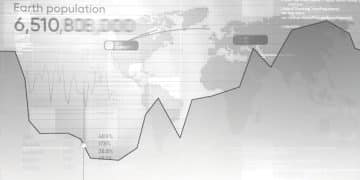Emergency Economic Measures: Navigating Market Volatility

Governments implement emergency economic measures, including fiscal stimulus and monetary policy adjustments, as direct responses to acute market volatility, aiming to stabilize economies and restore confidence during crises.
In times of significant financial distress and uncertainty, governments often deploy a range of decisive interventions. Understanding the complexities of Emergency Economic Measures: Understanding the Government’s Response to Recent Market Volatility becomes crucial. These actions, designed to mitigate economic downturns and foster recovery, directly impact individuals and businesses, shaping the financial landscape for years to come.
Understanding Market Volatility and Its Triggers
Market volatility, characterized by rapid and unpredictable swings in financial asset prices, is a fundamental aspect of modern economies. While often perceived negatively, it also presents opportunities for astute investors. However, extreme volatility, especially when coupled with significant external shocks, can pose systemic risks, necessitating government intervention.
Defining Market Volatility
Volatility is a statistical measure of the dispersion of returns for a given security or market index. Higher volatility means that the value of an investment can change dramatically over a short period. This can be driven by a multitude of factors, both internal and external to the market. Understanding these dynamics is the first step toward appreciating the need for and nature of emergency economic measures.
- Price Fluctuation: Rapid and significant upswings or downswings in asset values.
- Uncertainty: A general sense of unpredictability regarding future economic conditions.
- Investor Behavior: Emotional responses like fear and panic can exacerbate price swings.
Key Triggers of Extreme Volatility
Several events can catalyze widespread market instability. These often include geopolitical crises, natural disasters, public health emergencies, and breakdowns in financial systems. Each of these can disrupt supply chains, reduce consumer demand, or erode investor confidence, leading to a cascade of negative effects throughout the economy.
For example, a sudden global pandemic can halt economic activity, leading to widespread job losses and a sharp decline in consumption. Similarly, significant geopolitical conflicts can disrupt global trade routes, increase commodity prices, and create an environment of uncertainty that deter investment. Identifying these triggers early allows policymakers to anticipate potential crises and prepare appropriate responses, although the full impact is rarely fully foreseeable.

In conclusion, market volatility, while inherent, can escalate to dangerous levels when external shocks combine with underlying economic fragilities. Recognizing its different forms and triggers is paramount for understanding why governments feel compelled to enact emergency economic measures, often with significant implications for public finance and private sector stability.
The Spectrum of Emergency Fiscal Measures
When facing severe market volatility and economic distress, governments often resort to fiscal measures, which involve adjustments to public spending and taxation. These tools are designed to directly inject demand into the economy, support vulnerable populations, and stabilize key sectors. Their timely implementation can prevent deeper recessions and accelerate recovery, though they also entail significant fiscal costs.
Government Spending Initiatives
Increased government spending is a cornerstone of fiscal stimulus during crises. This can take various forms, from direct payments to citizens to large-scale infrastructure projects. The goal is to boost aggregate demand, thereby encouraging production and employment. Examples include unemployment benefits, direct cash transfers, and subsidies for struggling businesses, all aimed at bolstering purchasing power and preventing a collapse in demand.
- Direct Cash Transfers: Providing money directly to citizens to stimulate consumption.
- Unemployment Benefits Expansion: Extending and increasing payments to those who have lost jobs.
- Infrastructure Projects: Investing in long-term projects to create jobs and improve productivity.
Tax Policy Adjustments
Alongside spending, tax policies are often tweaked to provide immediate relief and incentives. This might involve temporary tax cuts for businesses or individuals, deferrals of tax payments, or targeted tax credits. The aim is to free up funds for investment, consumption, or to help businesses manage their cash flow during difficult periods. Such measures can quickly alleviate financial pressure on households and corporations.
For instance, reducing sales taxes can encourage consumer spending, while temporary cuts to corporate taxes might incentivize businesses to retain employees or invest in new equipment. However, balancing the need for immediate relief with long-term fiscal sustainability is a perpetual challenge for policymakers, as these measures directly impact government revenue. The effectiveness of these measures often depends on their scale, timing, and how broadly they are applied across the economy.
In essence, emergency fiscal measures represent a direct and often immediate government intervention into the economy. They are critical for stabilizing a tumultuous market but demand careful consideration of their intended and unintended consequences, particularly concerning national debt and inflation pressures.
Monetary Policy Tools in Crisis Management
Beyond fiscal interventions, central banks play a pivotal role in managing economic crises through monetary policy. These measures generally involve controlling the money supply and credit conditions, aiming to ensure liquidity in financial markets, reduce borrowing costs, and stabilize the banking system. Their actions are often more immediate than fiscal measures, though their impact can take time to fully materialize.
Interest Rate Adjustments
One of the central bank’s primary tools is adjusting the benchmark interest rate. During a crisis, central banks typically lower interest rates to encourage borrowing and spending, making it cheaper for businesses to invest and for consumers to purchase goods and services. Extremely low, or even negative, rates can stimulate economic activity by reducing the cost of capital and encouraging risk-taking.
However, once rates reach near-zero, the effectiveness of further rate cuts diminishes, leading central banks to explore unconventional measures. The impact of these adjustments can be far-reaching, influencing everything from mortgage rates to business loan costs, ultimately affecting the overall pace of economic growth and inflation.
- Rate Reductions: Cutting the benchmark rate to lower borrowing costs.
- Forward Guidance: Communicating future policy intentions to guide market expectations.
- Emergency Lending Facilities: Providing liquidity directly to financial institutions.
Quantitative Easing (QE) and Other Unconventional Measures
When conventional tools like interest rate cuts are no longer sufficient, central banks may resort to unconventional measures such as quantitative easing (QE). QE involves large-scale asset purchases, typically government bonds or other financial assets, from commercial banks. This injects liquidity into the financial system, lowers long-term interest rates, and encourages lending. The goal is to stimulate the economy when traditional monetary policy transmission mechanisms are impaired.
Other unconventional measures might include negative interest rates, where commercial banks are charged for holding reserves at the central bank, or targeted asset purchase programs designed to support specific sectors of the economy. These measures are often implemented with the understanding that they carry risks, such as potential asset bubbles or future inflation, but are deemed necessary given the severity of the crisis. The scale and duration of these programs must be carefully calibrated to avoid unintended consequences and ensure market stability.
Ultimately, monetary policy tools, both conventional and unconventional, are essential components of a government’s crisis management toolkit. They work in tandem with fiscal policies to restore economic stability, but their implementation requires careful navigation of potential trade-offs and future implications.
Regulatory Forbearance and Financial Stability
Beyond direct fiscal and monetary injections, governments and financial regulators often implement measures known as regulatory forbearance. This involves temporarily relaxing certain rules or deferring their enforcement to provide breathing room for financial institutions and borrowers during periods of acute economic stress. The goal is to prevent a cascade of defaults and bankruptcies that could exacerbate the crisis, while still upholding the long-term integrity of the financial system.
Easing Lending Standards
During a crisis, banks may become extremely risk-averse, leading to a credit crunch where even creditworthy borrowers struggle to access funds. Regulatory forbearance can address this by temporarily easing capital requirements or loan classification rules for banks. This allows them to continue lending, supporting businesses and individuals even when their financial health might appear precarious under normal circumstances. Such flexibility aims to keep credit flowing through the economy.
For example, rules on non-performing loans might be relaxed, allowing banks more time to work with struggling borrowers before classifying their loans as non-performing. This can prevent a rapid deterioration of banks’ balance sheets and avert a widespread seizing up of credit markets. However, these measures must be carefully managed to avoid fostering reckless lending practices in the long run.
- Capital Requirement Relaxations: Allowing banks to operate with lower capital buffers temporarily.
- Loan Classification Waivers: Providing flexibility in how banks categorize struggling loans.
- Debt Moratoriums: Allowing borrowers to temporarily pause loan repayments without penalty.
Consumer and Business Support Mechanisms
Regulatory forbearance also extends to direct support for consumers and businesses. This can include moratoriums on mortgage payments, deferrals on rent, or temporary suspensions of foreclosures and repossessions. These measures aim to protect households and small businesses from immediate financial ruin, preserving their ability to recover once the crisis subsides. Such protective actions can significantly reduce social and economic dislocation.
Regulators might also work with utility companies to ensure essential services are not cut off due to non-payment during the crisis. The intent is to provide a safety net, allowing individuals and enterprises to navigate the immediate shock without losing their homes or livelihoods, which would otherwise prolong the recovery process. The challenge lies in balancing immediate relief with the need to prevent moral hazard and ensure orderly market functioning after the crisis abates.
In summary, regulatory forbearance serves as a critical, often understated, component of emergency economic measures. By providing temporary flexibility within the financial system, it helps to prevent greater systemic collapse and supports the resilience of both financial institutions and the broader economy, paving the way for a more stable recovery.
International Coordination and Global Spillovers
In an increasingly interconnected global economy, market volatility and national economic crises rarely remain isolated. The spillover effects across borders necessitate significant international coordination in times of distress. Multilateral institutions and agreements become vital platforms for governments to work together, sharing information, harmonizing responses, and providing mutual support to mitigate global shocks.
Role of International Financial Institutions
Organizations like the International Monetary Fund (IMF) and the World Bank are crucial in facilitating international responses to economic crises. They provide financial assistance to countries in distress, often coupled with policy advice aimed at stabilizing their economies. Their role extends to monitoring global financial risks and fostering cooperation among member states to prevent crises from spreading. The IMF, for instance, can offer emergency loans to countries facing balance of payments problems, helping them manage foreign exchange shortages and maintain economic stability.
Similarly, the World Bank focuses on supporting longer-term development and poverty reduction, but also plays a role in crisis recovery through reconstruction and recovery loans. These institutions serve as vital backstops, providing liquidity and policy guidance that individual nations might not have on their own, especially developing economies most vulnerable to global shocks. Their interventions often come with policy conditions aimed at ensuring sustainable economic practices post-crisis.
- IMF Lending: Providing emergency loans to countries facing financial instability.
- World Bank Support: Assisting with long-term recovery and economic development.
- Financial Stability Board (FSB): Coordinating regulatory policies across countries.
Cross-Border Policy Harmonization
Effective crisis management demands a degree of policy harmonization among major economies. This can involve coordinated interest rate cuts, joint fiscal stimulus packages, or synchronized regulatory changes to avoid competitive devaluations or capital flight. Discussions at forums like the G7 and G20 are critical for fostering consensus and commitment on global economic strategies, ensuring that national measures do not inadvertently undermine collective efforts.

For example, during the 2008 financial crisis, central banks across leading economies implemented coordinated rate cuts to inject global liquidity. This collective action amplified the impact of individual national measures, demonstrating the power of synchronized policy responses. Achieving such coordination, however, can be challenging due to differing national priorities and political considerations, but its absence can leave individual economies vulnerable to broader systemic risks.
In essence, in an interconnected world, a purely domestic approach to emergency economic measures is often insufficient. International coordination, facilitated by multilateral institutions and intergovernmental forums, is indispensable for managing global spillovers and ensuring a more robust and widespread recovery from market volatility.
Assessing the Long-Term Implications and Exit Strategies
While emergency economic measures are essential for short-term crisis mitigation, their long-term implications are profound and require careful consideration. Governments must not only navigate the immediate turbulence but also plan for a strategic unwinding of these interventions. The timing and sequencing of exit strategies are critical to avoid unintended consequences such as inflation, asset bubbles, or fiscal instability.
Economic Debt and Inflationary Pressures
A primary long-term concern is the substantial increase in public debt that often accompanies large-scale fiscal stimulus. Governments borrow heavily to fund these measures, which can lead to higher taxes or reduced public services in the future. Moreover, expansive monetary policies, such as quantitative easing, can inject vast amounts of liquidity into the economy, potentially leading to inflationary pressures once demand recovers. Managing this delicate balance between stimulating growth and controlling inflation is a continuous challenge.
Excessive national debt can also crowd out private investment and potentially lead to higher interest rates for future government borrowing, creating a cycle of increasing debt servicing costs. Meanwhile, uncontained inflation erodes purchasing power, disproportionately affecting those on fixed incomes and undermining economic stability. Therefore, a credible plan for fiscal consolidation and monetary normalization is paramount to maintain investor confidence and long-term economic health.
- Fiscal Consolidation: Reducing budget deficits through spending cuts or tax increases.
- Monetary Normalization: Gradually raising interest rates and unwinding asset purchase programs.
- Prudent Fiscal Management: Emphasizing long-term budget sustainability.
Unwinding Emergency Interventions
The process of unwinding emergency measures, often referred to as “exiting” the crisis policy stance, is fraught with difficulty. Central banks must carefully manage the reduction of their balance sheets and the gradual increase of interest rates without derailing the recovery or triggering new market instability. Similarly, governments must phase out fiscal support programs while ensuring that the economy is strong enough to stand on its own without artificial stimulation.
Premature withdrawal of support can lead to a “double-dip” recession, while delaying too long can breed inflation or inflate asset bubbles. The art of the exit strategy lies in its flexibility and responsiveness to evolving economic conditions. Policymakers often rely on data-driven decisions and clear communication to guide market expectations and ensure a smooth transition back to more conventional economic management. This involves a delicate calibration, often balancing political pressures with economic imperatives, proving to be as challenging as the initial crisis response.
In conclusion, while emergency economic measures provide crucial life support during crises, careful planning for their long-term implications and a well-executed exit strategy are indispensable. These considerations ensure that short-term stability does not come at the cost of future economic health, setting the stage for sustainable prosperity.
Future Preparedness and Policy Evolution
The experience of recent market volatility and economic crises has underscored the importance of dynamic policy frameworks and continuous learning for governments worldwide. Building resilience into economic systems and adapting to new types of risks are essential for future preparedness, minimizing the impact of unforeseen shocks. This evolutionary approach to policy development is not merely reactive but proactively seeks to anticipate and mitigate emerging threats.
Strengthening Economic Resilience
Future preparedness involves strengthening the underlying resilience of economies. This means fostering robust financial systems, diversifying economic sectors to reduce over-reliance on a few industries, and improving social safety nets to protect vulnerable populations. Investing in digital infrastructure and sustainable technologies also contributes to long-term stability by boosting productivity and creating new avenues for growth. A resilient economy is better equipped to absorb shocks without necessitating drastic emergency interventions.
Furthermore, building fiscal buffers during periods of prosperity, such as maintaining lower national debt levels and robust reserve funds, provides governments with more room to maneuver during a downturn without immediately resorting to emergency borrowing. These proactive measures ensure that resources are available when needed most, preventing minor disruptions from escalating into full-blown crises.
The emphasis on structural reforms that enhance labor market flexibility, promote innovation, and improve educational outcomes also contributes to a more adaptable and robust economy, less susceptible to the cyclical nature of economic performance. These are long-term investments that pay dividends when the next crisis inevitably hits.
Adapting to New Risks and Global Challenges
The evolving global landscape presents new and complex risks, from climate change and pandemics to cyber warfare and rapid technological disruption. Future economic policies must be agile enough to adapt to these challenges, developing new tools and cooperative frameworks beyond traditional fiscal and monetary measures. This requires a deeper understanding of interconnected systems and the potential for cascading failures across multiple domains. A holistic approach that integrates economic, social, and environmental considerations is increasingly vital.
Collaboration between national governments, international organizations, and the private sector is also key to addressing global challenges that transcend national borders. Sharing best practices, coordinating research, and establishing early warning systems can enhance collective preparedness. The goal is to move beyond merely reacting to crises towards a more proactive and preventative policy stance, ensuring that global economies are better armored against the next major shock, whatever its form. This ongoing evolution of policy thinking and implementation is essential to securing long-term stability and widespread prosperity.
In conclusion, future preparedness extends beyond the immediate aftermath of a crisis, demanding a strategic commitment to strengthening economic resilience and adapting policy frameworks to an ever-changing world. By learning from past experiences and anticipating future challenges, governments can build more robust and responsive economies, reducing the need for drastic emergency measures.
| Key Point | Brief Description |
|---|---|
| 📊 Market Volatility Triggers | Unpredictable swings driven by geopolitical, health, or financial shocks. |
| 💰 Fiscal Measures | Government spending and tax adjustments to inject demand and support. |
| 🏦 Monetary Policy | Central bank actions to control money supply, like interest rate cuts and QE. |
| 🌍 Global Coordination | International efforts to synchronize responses and mitigate cross-border spillovers. |
Frequently Asked Questions About Emergency Economic Measures
Emergency economic measures are swift and decisive actions taken by governments and central banks to stabilize an economy during periods of extreme market volatility or crisis. These typically involve fiscal policies like increased spending and tax adjustments, and monetary policies such as interest rate changes and quantitative easing, aiming to restore confidence and prevent deeper economic downturns.
Fiscal measures stabilize the economy by directly injecting demand. This includes government spending on infrastructure, direct payments to citizens, or expanded unemployment benefits, which boost consumer purchasing power. Tax cuts or deferrals for businesses and individuals also provide immediate financial relief, encouraging investment and protecting jobs during economic downturns.
Central banks manage market volatility primarily through monetary policy. They lower interest rates to encourage borrowing and investment, and implement unconventional measures like quantitative easing (QE) to inject liquidity into financial markets. Their actions aim to ensure credit flow, reduce borrowing costs, and stabilize the banking system to prevent financial collapse during crises.
Regulatory forbearance involves temporarily relaxing financial rules or deferring their enforcement. It’s important because it provides financial institutions and borrowers with a cushion during crises, preventing widespread defaults and bankruptcies. This flexibility helps maintain liquidity in the banking system, allowing credit to continue flowing and protecting vulnerable sectors of the economy from cascading failures.
The long-term implications include increased public debt due to large fiscal stimulus and potential inflationary pressures from expansive monetary policies. Governments must plan careful exit strategies to unwind these interventions without triggering new instability. Balancing short-term relief with long-term fiscal sustainability and growth is a continuous challenge for policymakers in the aftermath of a crisis.
Conclusion
As we navigate an increasingly unpredictable global economic landscape, the need for agile and effective Emergency Economic Measures: Understanding the Government’s Response to Recent Market Volatility remains paramount. From direct fiscal injections to nuanced monetary policies and international coordination, these interventions are critical for stabilizing economies in distress. While essential for short-term relief, their long-term implications, including increased debt liabilities and potential inflationary pressures, demand careful consideration and well-calibrated exit strategies. Ultimately, building structural resilience and fostering proactive policy evolution will be key to mitigating future shocks, ensuring a more stable and prosperous global economic future for all.





